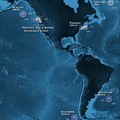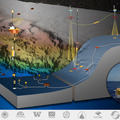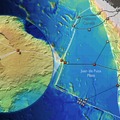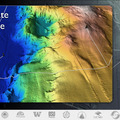The University of Washington is leading the effort to develop the Regional Scale Nodes (RSN) component of the National Science Foundation's Ocean Observatories Initiative. The cabled underwater research facility will be constructed in the northeast Pacific Ocean off the coasts of Washington and Oregon. Building off of last year's ENLIGHTEN'10 expedition, this year's VISIONS'11 cruise continues to lay the foundation for the installation of the secondary infrastructure (nodes, junction boxes, sensors, moorings, and extension cables) on the high-power and high-bandwidth RSN cabled observatory that will span the Juan de Fuca tectonic plate and cover 2 focused research areas: Hydrate Ridge and Axial Seamount.
Leg 1: Hydrate Ridge
Hydrate Ridge, the focus site for Leg 1 of VISIONS'11, is one of the most well studied gas hydrate systems in the world's oceans because it hosts abundant methane hydrate deposits, sites of active venting of fluids and methane-rich gases, and dense microbial and animal communities fueled by the seeps. An array of chemical, biological, and geophysical sensors at this site, which will be installed in 2013, will allow the first long-term, detailed investigation of these systems. In situ cameras, flow sensors, and a mass spectrometer will allow investigation of how changes in fluid flow and chemistry impact the biological communities that thrive in this environment.
Leg 2: Axial Seamount
Axial Seamount, the focus site for Leg 2 of VISIONS'11, is the most magmatically robust site along the Juan de Fuca Ridge and is seismically, magmatically, and hydrothermally active. It is located on the Juan de Fuca spreading center and hosts three known active hydrothermal fields (ASHES, CHASM, and CASTLE). As part of OOI, Axial Seamount will be the site of a major installation of seafloor biological, chemical, and geophysical sensors cabled to the Internet. In concert, this array will provide unparalleled new insights into how submarine volcanoes work, how seismic events perturb seafloor hydrothermal systems, and the temporal and spatial evolution of novel life forms that are unique to these environments.





